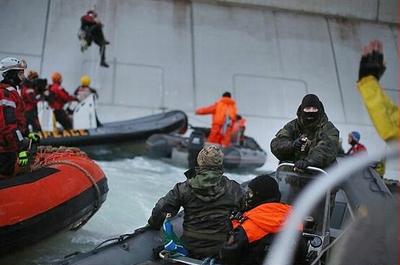
AMSTERDAM, The Netherlands, September 18, 2013 (ENS) – The Russian Coast Guard has fired shots at a Greenpeace International ship in the Russian Arctic and two Greenpeace activists were arrested today during a protest of oil drilling in the fragile, pristine environment.
At 4.30 am Moscow time, five inflatable boats were launched from the Greenpeace International ship Arctic Sunrise and headed towards the Gazprom oil rig Prirazlomnaya in the remote Pechora sea. One of the inflatables was confronted by the Russian Coast Guard.

Two activists who attached themselves to the oil platform have been arrested – Sini Saarela of Finland and Marco Weber from Switzerland.
Saarela said before undertaking the protest, “This rusty oil platform is an Arctic disaster waiting to happen. We’re hundreds of miles away from emergency response vessels or independent observers, but right next to a pristine Arctic environment that’s home to polar bears, walruses and rare seabirds.”
Eyewitness Camila Speziale, a Greenpeace activist from Argentina, reports, “It was a terrifying moment for me as I jumped into the inflatable boat in total darkness; I knew the Russian Coast Guard was waiting for us. They had been on our tail since Monday, watching our every move, and I could see the huge water cannons in the distance. But we had a mission and we were determined: to stop the world’s first oil from being produced from ice-filled Arctic waters.”
“It didn’t take long to reach the platform and when I did, two of the climbers had already managed to get a line up so we could start our ascent. Before I had a chance to scale the platform, two boats headed towards us from the Coast Guard vessel, with people wearing military camouflage clothing and balaclavas. It felt like I was living through a horror movie as they rammed into us.”
“My fellow climber, Sini, fell into the water. … We rescued her from the water but they made it extremely difficult for us by continuing to ram our boats.”
“Amongst all the commotion I heard a gunshot. They were shouting at us in Russian so I couldn’t understand what they were saying, but they were pointing guns and knives at us so I knew they were threatening us. All we could do was raise our hands and explain that we were here to protest peacefully. Then I heard another shot.”
“Sini, who had managed to get back onto the rope was in a vulnerable position and Kruso who had made it up quite high was being pelted by the water cannons,” blogged Speziale on the Greenpeace International site.
“Half an hour on and the guns were still being fired into the air and water. Sini and Kruso were still taking the brunt of the water cannons – it looked so heavy on their heads. After some time they decided they couldn’t go on any longer and started their descent. But the workers on the platform didn’t notice or didn’t listen — they carried on firing the water cannons at them and the Coast Guards started pulling their ropes so they’d land in their boat instead,” wrote Speziale.
“They took my friends without saying a word and headed back to the Coast Guard ship. My heart stopped for them,” she wrote. “The gunshots continued and I wondered how far these people were willing to go to stop us from peacefully protesting against Arctic oil.”
Crew members of the Arctic Sunrise reported that a total of 11 warning shots were fired across the ship and the Russian Coast Guard threatened to fire at the ship itself if it does not leave the area immediately.
There are now no climbers remaining on the drilling platform, but the Greenpeace International icebreaker Arctic Sunrise remains in the area.
A request by the Russian Coast Guard to board the Arctic Sunrise has been refused by the ship’s captain Peter Wilcox, who assumed command of the ship on Sunday. Greenpeace International maintains that such a boarding is “unjustified and illegal.”
In August 2012 Greenpeace activists including the organization’s executive director, Kumi Naidoo occupied the same drilling platform.
“Last year we blocked this platform for five days and we’re back to stop Gazprom for good,” Saarela said. “This is an era-defining battle – do we allow vast companies to drill for more of the oil that’s melting the Arctic and wrecking our climate, or do we draw a line in the ice and say enough?”
Gazprom plans to start production from the Prirazlomnaya platform in the first quarter of 2014, raising the risk of an oil spill in an area that contains three nature reserves protected by Russian law.
The company has signed a deal with Royal Dutch Shell to exploit Russia’s Arctic shelf. Although joint Shell-Gazprom drilling operations remain some years away, the partnership will expose Shell’s investors to the risks associated with Russia’s chaotic oil industry, says Greenpeace.
Last month Russian authorities denied the icebreaker Arctic Sunrise permission to enter the Northern Sea Route to protest Arctic oil drilling.
The ship entered the area regardless because he says the ship meets all required standards for ice class vessels. The Russian coast guard subsequently boarded the ship and ordered its captain to leave the area under the threat of preventative fire, leading the Dutch government, under whose flag the vessel sails, to demand an explanation.
Copyright Environment News Service (ENS) 2013. All rights reserved.
© 2013, Environment News Service. All rights reserved. Content may be quoted only with proper attribution and a direct link to the original article. Full reproduction is prohibited.
